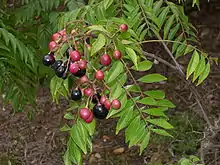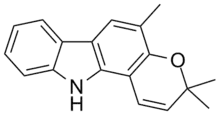| Curry tree | |
|---|---|
 | |
| Scientific classification | |
| Kingdom: | Plantae |
| Clade: | Tracheophytes |
| Clade: | Angiosperms |
| Clade: | Eudicots |
| Clade: | Rosids |
| Order: | Sapindales |
| Family: | Rutaceae |
| Genus: | Bergera |
| Species: | B. koenigii |
| Binomial name | |
| Bergera koenigii | |
| Synonyms[3] | |
| |
The curry tree or Bergera koenigii (syn.Murraya koenigii), is a tropical and sub-tropical tree in the family Rutaceae (the rue family, which includes rue, citrus, and satinwood), native to Asia.[4] The plant is also sometimes called sweet neem, though M. koenigii is in a different family to neem, Azadirachta indica, which is in the related family Meliaceae.
Its leaves, known as curry leaves, also referred to as sweet neem, are used in many dishes in the Indian subcontinent.
Description

.jpg.webp)

It is a small tree, growing 4–6 metres (13–20 ft)) tall, with a trunk up to 40 cm (16 in) in diameter. The aromatic leaves are pinnate, with 11–21 leaflets, each leaflet 2–4 cm (3⁄4–1+1⁄2 in) long and 1–2 cm (1⁄2–3⁄4 in) broad. The plant produces small white flowers which can self-pollinate to produce small shiny-black drupes containing a single, large viable seed. The berry pulp is edible, with a sweet flavor.[5]
Distribution and habitat
The tree is native to the Indian subcontinent.[6] Commercial plantations have been established in India, and more recently Australia.[6]
It grows best in well-drained soil that does not dry out, in areas with full sun or partial shade, preferably away from the wind. Growth is more robust when temperatures are at least 18 °C (64 °F).[7]
Etymology and common names
The word curry derives from the Tamil word kari, the name of the plant associated with the perceived blackness of the tree's leaves.[8] The records of the leaves being utilized are found in Tamil literature dating back to the 1st and 4th centuries CE. Britain had spice trades with the ancient Tamil region. It was introduced to England in the late 16th century..
The species Bergera koenigii was first published by Carl Linnaeus in Mantissa Plantarum vol.2 on page 563 in 1767.[3] It was formerly known as Murraya koenigii (L.) Spreng., which was first published in Syst. Veg., ed. 16. 2: 315 in 1825.[9] Some sources still recognise it as the accepted name.[10]
The former generic name, Murraya, derives from Johan Andreas Murray (1740–1791), who studied botany under Carl Linnaeus and became a professor of medicine with an interest in medicinal plants at the University of Göttingen, Germany.[4] The specific name, koenigii, derives from the last name of botanist Johann Gerhard König.
The curry tree is also called curry leaf tree or curry bush, among numerous local names, depending on the country.[11][5]
Uses
Culinary
The fresh leaves are an indispensable part of Indian cuisine and Indian traditional medicines. They are most widely used in southern and west coast Indian cooking, usually fried along with vegetable oil, mustard seeds and chopped onions in the first stage of the preparation. They are also used to make thoran, vada, rasam, and kadhi; additionally, they are often dry-roasted (and then ground) in the preparation of various powdered spice blends (masalas), such as South Indian sambar masala, the main seasoning in the ubiquitous vegetable stew sambar. The curry leaves are also added as flavoring to masala dosa, the South Indian potato-filled crepes, made with a mildly probiotic, fermented lentil and rice batter. The fresh leaves are valued as seasoning in the cuisines of South and Southeast Asia.[5] In Cambodia, curry leaves (Khmer: ស្លឹកកន្ទ្រោប, slœ̆k kontroap) are roasted and used as an ingredient for samlor machu kroeung.[7] In Java, the leaves are often stewed to flavor gulai. Though available dried, the aroma and flavor are greatly inferior.[6] The oil can be extracted and used to make scented soaps.[7]
The leaves of Murraya koenigii are also used as a herb in Ayurvedic and Siddha medicine in which they are believed to possess anti-disease properties,[7][5] but there is no high-quality clinical evidence for such effects.
The berries are edible, but the seeds may be toxic to humans.
Propagation
Seeds must be ripe and fresh to plant; dried or shriveled fruits are not viable. The skin must be peeled off, and this is recommended before planting.[12] One can plant the whole fruit, but it is best to remove the pulp before planting in a potting mix that is kept moist but not wet. Stem cuttings can be also used for propagation.[4] In India, it is mainly planted privately, but also cultivated commercially to a small extent.[13]
Chemical constituents

Compounds found in curry tree leaves, stems, bark, and seeds include cinnamaldehyde,[14] and numerous carbazole alkaloids, including mahanimbine,[15] girinimbine,[16] and mahanine.
Nutritionally, the leaves are a rich source of carotenoids, beta-carotene, calcium and iron.[17]
References
- ↑ Plummer, J. (2021). "Curry Leaf, Murayya koenigii". IUCN Red List of Threatened Species. 2021: e.T156236806A166564522. doi:10.2305/IUCN.UK.2021-2.RLTS.T156236806A166564522.en. Retrieved 6 March 2021.
- ↑ "Murraya koenigii". Germplasm Resources Information Network. Agricultural Research Service, United States Department of Agriculture.
- 1 2 "Bergera koenigii L." Plants of the World Online. Kew Science. Retrieved 16 November 2023.
- 1 2 3 "Murraya koenigii". Missouri Botanical Garden, St. Louis, MO, USA. 2019. Retrieved 13 August 2019.
- 1 2 3 4 "Murraya koenigii (L.) Spreng". From: Parmar, C. and M. K. Kaushal. 1982. Murraya koenigii. pages 45–48. In: Wild Fruits. Kalyani Publishers, New Delhi, India. In: NewCROP, New Crop Resource Online Program, Center for New Crops and Plant Products, Purdue University. 1982. Retrieved 14 August 2019.
- 1 2 3 Norman, Jill (2002). Herbs & Spices: The Cook's Reference. New York, New York: DK Publishing. pp. 212, 213. ISBN 9780789489395. OCLC 51005062.
- 1 2 3 4 "Curry leaf tree (Murraya koenigii)". Heritage Garden. Retrieved 2019-04-02.
- ↑ "Curry and curry tree". Online Etymology Dictionary. 2023. Retrieved 16 May 2023.
- ↑ "Murraya koenigii (L.) Spreng. | Plants of the World Online | Kew Science". Plants of the World Online. Retrieved 16 November 2023.
- ↑ George, A.S.; Orchard, A.E.; Hewson, H.J. (1993). Oceanic islands 2. Flora of Australia (50 ed.). Canberra: Australian Government Publishing Service. pp. 1–606.
- ↑ "Murraya koenigii (curry leaf tree)". CABI. 14 July 2018. Retrieved 13 August 2019.
- ↑ "How to Peel Skin Of Curry Leaf Seeds to Grow Plants". Curry Leaf Plants. 27 February 2023. Retrieved 2023-03-11.
- ↑ "Indian Spices". 2008-07-23. Archived from the original on 2008-07-23. Retrieved 2022-09-23.
- ↑ Sankar Ganesh, Ravishankar Rai; et al. (2015). "In vitro antibiofilm activity of Murraya koenigii essential oil extracted using supercritical fluid CO2 method against Pseudomonas aeruginosa PAO1". Natural Product Research. 29 (24): 2295–2298. doi:10.1080/14786419.2015.1004673. ISSN 1478-6427. PMID 25635569. S2CID 220349399.
- ↑ "Mahanimbine". PubChem. 2017.
- ↑ "Girinimbine". PubChem. 2017.
- ↑ Drisya, C. R.; Swetha, B. G.; Velu, V.; Indrani, D.; Singh, R. P. (January 2015). "Effect of dried Murraya koenigii leaves on nutritional, textural and organoleptic characeteristics of cookies". Journal of Food Science and Technology. 52 (1): 500–506. doi:10.1007/s13197-013-1002-2. S2CID 96236829.
External links
 Media related to Murraya koenigii at Wikimedia Commons
Media related to Murraya koenigii at Wikimedia Commons
- ↑ "Murraya koenigii (L.) Spreng. | Plants of the World Online | Kew Science". Plants of the World Online. Retrieved 2023-10-02.

